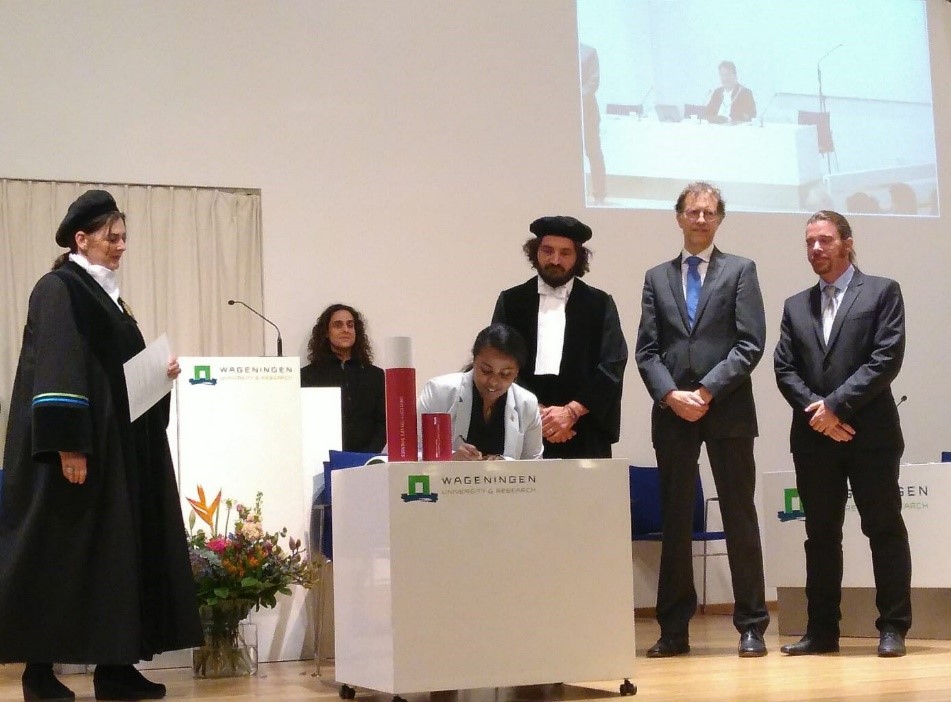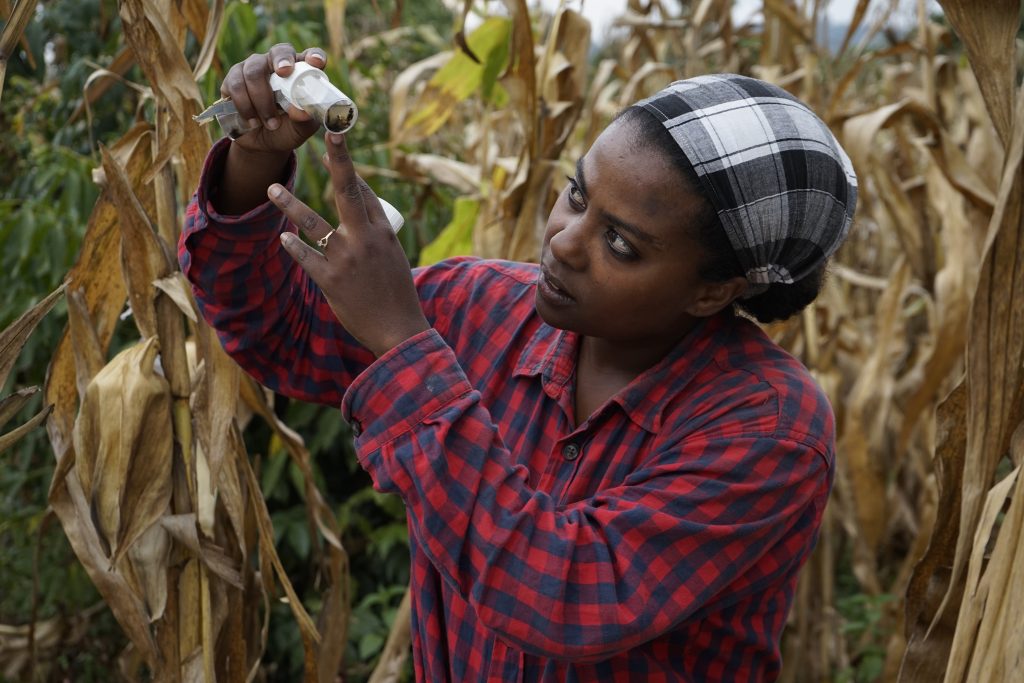
Pest management must consider the landscape context according to ATTIC project PhD thesis
by Carolyn Cowan
The control of crop pests has long been linked with chemical products like pesticides and insecticides. However, chemicals are often too expensive for smallholder farmers and require careful, appropriate use to ensure effectiveness. What if we could take advantage of natural ecological processes to suppress unwanted organisms, lessening our reliance on external inputs? This is the topic addressed in “Hide and seek: management and landscape factors affecting maize stemborers, Busseola fusca, infestation levels in Ethiopia,” the recent Ph.D. thesis by Yodit Kebede, completed at Wageningen University, Netherlands with support from the CGIAR Research Program on Maize (MAIZE) and the International Maize and Wheat Improvement Center (CIMMYT). The implications of the research hold significance for prominent pest control challenges like fall armyworm in Africa and beyond.

Part of the Agro-ecosystem Diversity, Trajectories and Trade-Offs for Intensification of Cereal-based systems project (ATTIC), Kebede’s research assesses the performance of biological control for maize stemborers in Ethiopia, in particular the ‘push-pull’ system, across a gradient of landscape diversity and complexity, while taking into account how communities manage their landscape.
ATTIC is a collaboration between MAIZE and Wageningen University and studies the past and present trajectories of farming systems in four countries – Bangladesh, Ethiopia, Mexico and Nepal – to help research have greater impact through new technologies, practices and policies.
“Maize stemborers are among the most damaging insect pests, causing variable but sometimes devastating yield losses,” said Kebede. “There is a need for affordable strategies that can reduce pest incidence while improving soil fertility and providing fodder production. Such solutions increase both food security and household incomes for smallholder farmers.”
Push-pull pest control
The push-pull system involves intercropping cereals with herbaceous legumes, surrounded by fodder grasses. The “push” comes from the legumes, which emit chemicals that repel stemborers, while the ‘pull’ comes from the fodder grasses that attract and trap the stemborers. It as a promising crop diversification strategy for smallholder farmers in Africa as it may contribute to maize stemborer suppression, while offering further benefits like improving soil fertility through legume nitrogen fixation and providing feed for livestock.
Kebede found that in landscapes of very diverse mixed land use – comprising grassland and other natural stemborer habitats – and intensively farmed maize-dominated land, the effect of the push-pull system on pest incidence was insignificant. However, when the surrounding landscape is of intermediate complexity, the push-pull method had a positive effect on pest control, suggesting the success of biological pest control is very much dependent on the surrounding landscape context.
Her thesis assessed the social and ecological processes that have shaped the landscape in order to understand some of the ecosystem services that agriculture is providing, particularly pest control. Through a multidisciplinary approach combining Geographic Information Systems (GIS) and remote sensing, field trials, and household surveys she was able to visualize and understand the drivers of land use change in Ethiopia at a landscape scale.
She observed how population growth is driving fast-paced change in land use, making farms smaller and smaller as farmland and natural habitats are fragmented and cleared to accommodate people. Farmers adopt different strategies to cope with this effect. Some diversify their livelihoods into off-farm activities, some plant cash crops, while others consolidate by sharing land, harvests and livestock grounds.
“It is clear we cannot approach pest control from a plot or farm scale perspective only,” explains Kebede. “We must look at the overall landscape setting and consider farmers’ needs to select which control methods will offer the most effective pest management solution. A landscape approach is required and is a vital consideration in the control of major threats like fall armyworm.”

Building a career in agricultural science
Kebede says her childhood spent in Africa greatly influenced her career path. “Being raised in Africa, living for periods in Ethiopia, Madagascar and Guinea, I was immersed in the challenges the continent faces,” she says. “I was drawn to agricultural studies and remain motivated to contribute towards solving these challenges.”
She studied Agricultural Engineering at ENITA, Clermont-Ferrand in France and International Land and Water Management at Wageningen University, Netherlands and worked for five years as a consultant and research assistant before commencing her PhD studies. She believes her experiences in several African and European countries, and fieldwork in tropical environments have enriched her perspective, broadening her scope as a researcher.
The multidisciplinary nature of the ATTIC project attracted Kebede. “I enjoy taking a holistic approach. Even though the entry point of my research was maize stemborers, the context was much broader, encompassing declining soil fertility, lack of fodder and socio-economic constraints.”
Kebede valued working in collaboration between her university and CIMMYT, and reflects on her work alongside supervisors, Pablo Tittonell and Felix Bianchi from Wageningen University, and Frederic Baudron from CIMMYT: “Working alongside a more applied research organization like CIMMYT, as part of an international team, meant I had a range of experience to draw upon, from landscape ecology to agronomy and farming systems approaches.” said Kebede. “Working with such a range of institutions and ATTIC colleagues across different countries meant there was ample opportunity to share and learn from each other.”
Africa, ATTIC, Ethiopia, farming systems, Landscape ecology, pest management, PhD, stem borers
